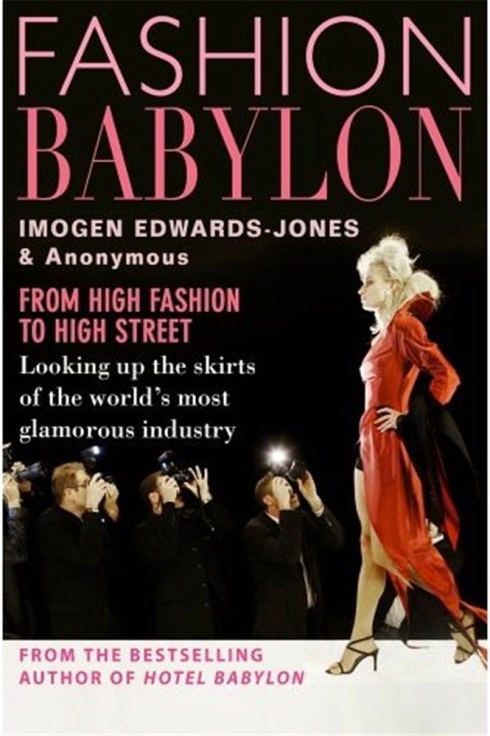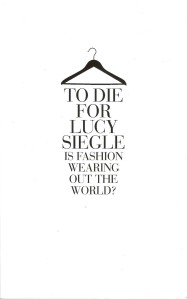Sometime ago, a co-worker of mine came up to me and said: “You can’t like fashion and not have read this”. Afterwards, she slapped the book on my desk.
So, we decided to do a book exchange. She handed me Fashion Babylon, I gave her Tabloid Girl by Sharon Marshall, and before I start my review, I’d like to say that both books were in the same league as they were full of clichés, but perhaps in retrospect, Tabloid Girl was funnier.
The ugly truth about fashion…
… which you most probably know already. The dirt here, while interesting, will not really be new to you if you are a keen fashion follower. Designers putting high street shirts on their catwalks last minute, models on laxatives and a 100 cigarette per day diet… Well, maybe I did not know that the aforementioned diet also included a pack of Haribo a month. It’s fair to say that while I was aware of a great deal of these “true stories”, they were weaved into the book wonderfully. I enjoyed every bit of the gossip and the humour.
The main character…
… is a designer of an emerging small label. The book starts right after the brand’s show during London Fashion Week, which was open to the style press’ scrutiny and slaughter. I found her feelings similar to those of Isaac Mizrahi’s in a documentary about his job as a designer, Uzipped (1995). Whilst the main character is fictional (or so the author says) I can’t stop wondering who it is based on. I really want to know. Really.
Coke…
… snort here, snort there. Not to snort before 4PM here, to snort at 11AM there. In a nutshell, there’s a lot of snorting going on in the fashion world.
Goddamn designers don’t make clothes in my size…
… and this book explains why. While I will not expose the particular logic behind this, I can tell you that the reason why you will probably not find a default size 18 Chanel dress is much more banal than you think. Just so you know, it’s not because curvaceous figures aren’t welcome in the fashion world. On the contrary, the buyer is always right and as long as he or she has money to have sucked out of her, she will get even a size 60 made especially for her or him.
Those models look like humanoids…
… for a reason. Fashion Babylon will also educate you as to why you don’t remember any models’ faces these days, unlike the age of the supermodel, when Naomi, Linda, Eva and Kate ruled the fashion scene. If you really want to nail the model look and be at your thinnest, you will know how the catwalk queens do it. The author will not spare you the details of how Eastern European girls achieve the level of skinny which is celebrated in style magazines. Only you might not celebrate it.
The designer price tag…
… is not affordable for the mere mortal. Truth to be told, some designers themselves wouldn’t be able to buy the clothes they make. However, in this book you will find exactly why a cashmere sweater by super-awesome-brand-which-I-want-to-wear-right-now costs as much as it does. You’ll be able to judge for yourself if you still want it. To be fair, you probably will, because Sienna Miller wore it.
Celebrity’s designer gear…
… is free to them. Well, not always but often. In fact, some brands pay celebs to parade their pieces – I won’t tell how much and who, but you are probably have a couple of ideas. Yes, it is stupid that fashionistas who would sell their souls to the devil to carry an IT bag can’t afford it, and celebs who quite franky don’t give a rat’s ass about fashion are fed these stylish gems, which they are likely to pass on to their mums, sisters, friends or just dump in the trash.
Edwards-Jones leaves you with an idea about how serious or how plain dumb the industry can get, ending Fashion Babylon with someone simply asking the main character : What are your ideas for next season’s collection?
This made me love the author’s wit as the question symbolised a never ending cycle of the style world, and of course the fact that they all live in their own little bubble.
Positives: The style of writing – it’s to the point, funny and raw. Like any nice and dirty exposé should be. Another positive is he moment when a model is found handcuffed to a heater with two vibrators in her moments before a runway show. Yes, two. In her. Thought I’d repeat that.
Negatives: You won’t learn anything drastically new about the fashion world, most of the information is what you heard from your fashion obsessed friend or from your mum who kept it mean and truthful when you had your “I want to be a model” stage.
Recommend? Drugs, sex and beautiful people. I don’t think I need to say more.
Last time pret-a-reporter read To Die For: Is Fashion Wearing Out the World? by Lucy Siegle.


